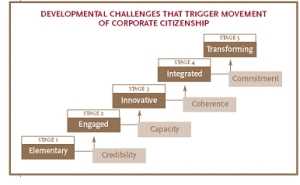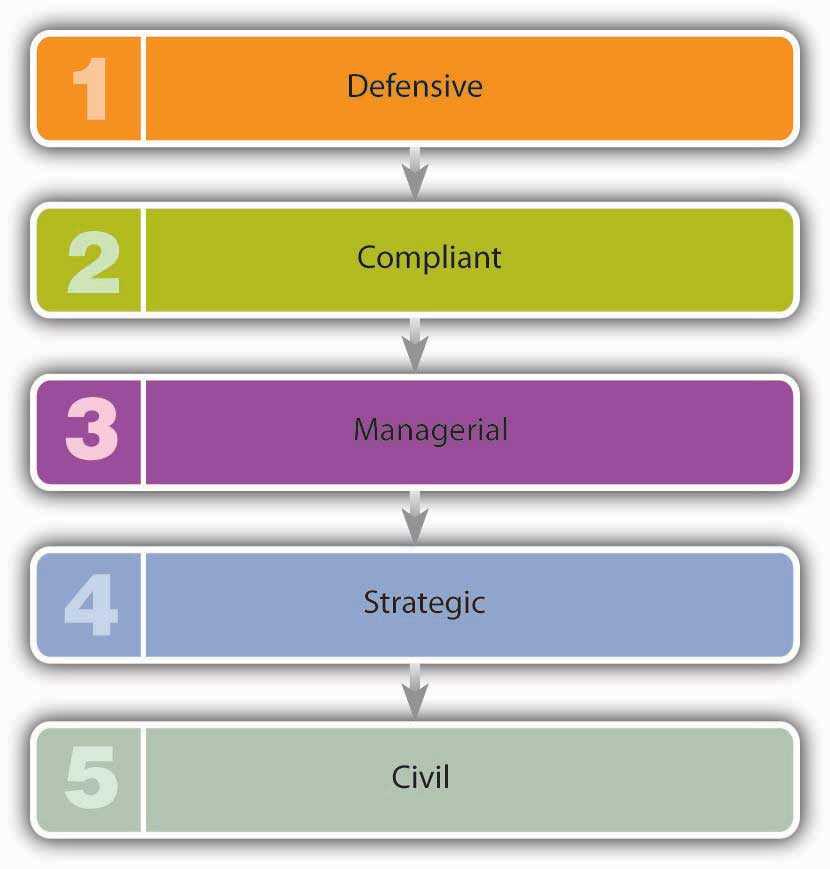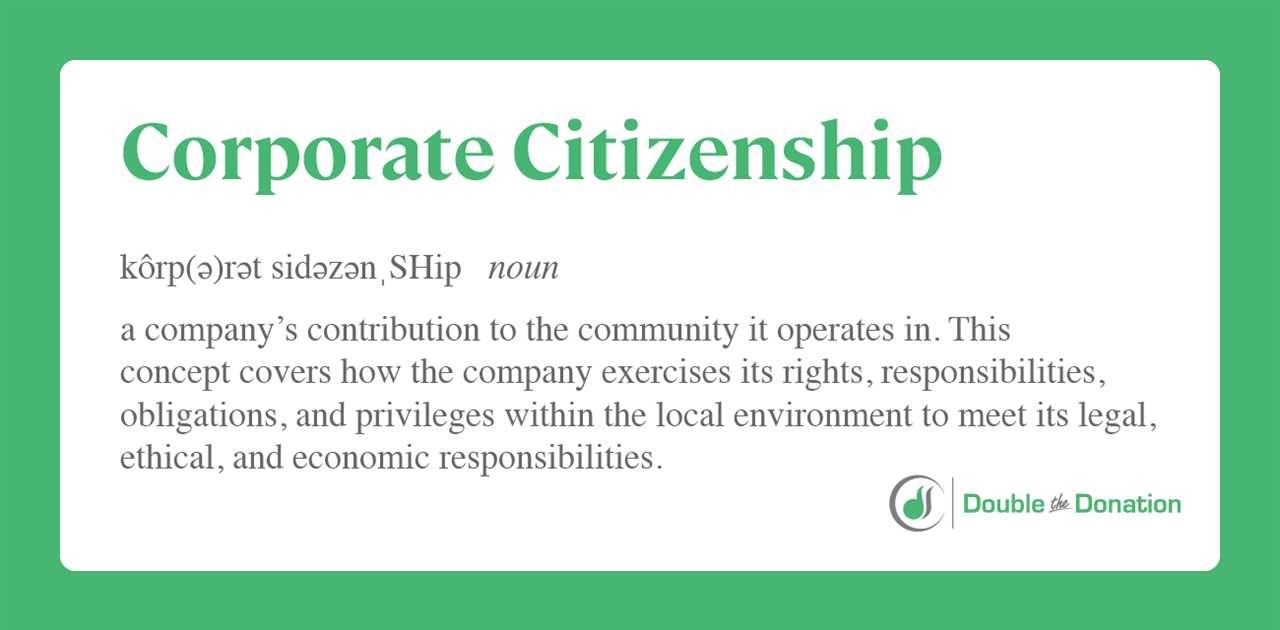Stage 3: Environmental Sustainability

Environmental sustainability is a crucial aspect of corporate citizenship. It involves taking responsibility for the impact a company has on the environment and implementing practices that minimize negative effects. This stage goes beyond compliance with environmental regulations and focuses on proactive measures to protect and preserve the planet.
Why is environmental sustainability important?
Environmental sustainability is important because it ensures the long-term viability of our planet. By adopting sustainable practices, companies can reduce their carbon footprint, conserve natural resources, and mitigate the negative effects of climate change. Additionally, consumers are increasingly demanding eco-friendly products and services, making sustainability a competitive advantage in the marketplace.
Real-Life Examples

1. Patagonia:
Outdoor clothing company Patagonia is known for its commitment to environmental sustainability. They have implemented various initiatives to reduce their environmental impact, such as using recycled materials in their products, offering repair services to extend the lifespan of their clothing, and donating a portion of their sales to environmental organizations. Patagonia also actively advocates for environmental causes and engages in activism to protect the planet.
2. Tesla:
Tesla, an electric vehicle and clean energy company, is at the forefront of environmental sustainability in the automotive industry. Their mission is to accelerate the world’s transition to sustainable energy. Tesla’s electric vehicles produce zero emissions, reducing air pollution and dependence on fossil fuels. They also develop and manufacture energy storage solutions, such as solar panels and batteries, to promote renewable energy usage.
3. Unilever:
Unilever, a multinational consumer goods company, has made significant efforts to integrate environmental sustainability into its operations. They have set ambitious goals, such as achieving zero waste to landfill and sourcing 100% of their agricultural raw materials sustainably. Unilever also invests in research and development to develop more sustainable products and packaging, aiming to reduce their environmental impact throughout the value chain.
Stage 4: Employee Engagement and Volunteerism
Employee engagement and volunteerism are essential aspects of corporate citizenship. This stage focuses on creating a positive work environment and encouraging employees to actively participate in community service and volunteer activities.
Companies that prioritize employee engagement and volunteerism understand the importance of fostering a sense of purpose and belonging among their workforce. They recognize that engaged employees are more likely to be productive, loyal, and satisfied with their jobs.
Here are some key elements of stage 4 in corporate citizenship:
1. Employee Volunteer Programs

Companies at this stage actively encourage their employees to volunteer their time and skills for charitable causes. They may offer paid time off for volunteering, organize group volunteer activities, or provide resources and support for employees to engage in individual volunteer work.
2. Skills-Based Volunteering
Skills-based volunteering involves utilizing employees’ professional skills and expertise to contribute to nonprofit organizations. Companies may offer pro bono consulting services, mentorship programs, or skill-sharing initiatives to empower their employees to make a meaningful impact in their communities.
3. Employee Giving Campaigns
Employee giving campaigns involve companies facilitating charitable donations from their employees. This can be done through payroll deductions, matching gift programs, or workplace giving platforms. These campaigns not only encourage philanthropy but also foster a sense of collective responsibility and unity within the organization.
4. Employee Resource Groups
Employee resource groups (ERGs) are voluntary, employee-led groups that bring together individuals with shared characteristics or interests. Companies at this stage support and encourage the formation of ERGs focused on community service and volunteerism. These groups provide a platform for employees to collaborate, organize volunteer activities, and drive positive change within and outside the company.
Overall, stage 4 of corporate citizenship emphasizes the importance of employee engagement and volunteerism in creating a positive social impact. By actively involving employees in community service and providing opportunities for them to contribute their skills and resources, companies can enhance their reputation, attract and retain top talent, and make a difference in the communities they operate in.
Stage 5: Social Impact and Community Development
In the fifth stage of corporate citizenship, companies focus on creating a positive social impact and contributing to community development. This stage goes beyond philanthropy and charitable giving, and instead, aims to make a lasting difference in society.
Companies at this stage understand that their success is intertwined with the well-being of the communities in which they operate. They actively seek opportunities to address social issues and contribute to the betterment of society.
Real-Life Examples
Another example is Microsoft, which has a strong focus on community development. Through their philanthropic arm, Microsoft Philanthropies, they provide technology and resources to underserved communities, aiming to bridge the digital divide and empower individuals through access to education and technology.
Benefits of Stage 5 Corporate Citizenship
Engaging in social impact and community development initiatives can have several benefits for companies. Firstly, it enhances their reputation and brand image. Consumers are increasingly conscious of a company’s social and environmental impact, and companies that actively contribute to society are more likely to gain customer loyalty and trust.
Secondly, it can attract and retain top talent. Employees are more likely to be attracted to companies that align with their values and have a positive impact on society. Engaging in community development initiatives also fosters a sense of pride and loyalty among employees, leading to higher job satisfaction and retention rates.
Lastly, companies that prioritize social impact and community development are more likely to have long-term success. By investing in the well-being of the communities they operate in, companies build strong relationships with stakeholders, including customers, employees, and local communities. This can lead to increased support, collaboration, and ultimately, business growth.
Stage 4: Employee Engagement and Volunteerism
Employee engagement and volunteerism are key components of corporate citizenship. This stage focuses on creating a positive and inclusive work environment where employees are encouraged to actively participate in volunteer activities and give back to their communities.
Companies that prioritize employee engagement and volunteerism understand the importance of fostering a sense of purpose and fulfillment among their workforce. They recognize that engaged employees are more likely to be motivated, productive, and loyal to the organization.
There are several ways in which companies can promote employee engagement and volunteerism:
- Volunteer Programs: Companies can establish formal volunteer programs that provide employees with opportunities to engage in community service. These programs may include paid volunteer time off, team-building activities, and partnerships with local nonprofits.
- Skills-Based Volunteering: Companies can leverage the skills and expertise of their employees by matching them with volunteer opportunities that align with their professional backgrounds. This allows employees to make a meaningful impact while developing new skills and expanding their networks.
- Employee Resource Groups: Employee resource groups (ERGs) are voluntary, employee-led groups that bring together individuals with shared interests or backgrounds. Companies can support ERGs focused on community service and encourage their members to organize volunteer activities.
- Corporate Giving Programs: Companies can offer matching gift programs or donation matching programs to encourage employees to contribute to charitable organizations. This not only increases the impact of employee donations but also demonstrates the company’s commitment to philanthropy.
By prioritizing employee engagement and volunteerism, companies can create a positive cycle of giving back. Engaged employees are more likely to volunteer, which in turn strengthens their connection to the company and fosters a culture of corporate citizenship.
- Google: Google offers its employees 20 hours of paid volunteer time off each year and provides grants to nonprofits where employees volunteer regularly.
- Salesforce: Salesforce encourages its employees to give back through its 1-1-1 model, where 1% of the company’s equity, time, and product are dedicated to philanthropy.
- IBM: IBM has a long history of employee volunteerism and offers a range of programs, including skills-based volunteering and pro bono consulting.
Overall, employee engagement and volunteerism play a crucial role in corporate citizenship, allowing companies to make a positive impact on their communities while fostering a sense of purpose and fulfillment among their employees.
Stage 5: Social Impact and Community Development
In the fifth stage of corporate citizenship, companies focus on creating a positive social impact and contributing to the development of their communities. This stage goes beyond philanthropy and charitable giving, and instead aims to address social issues and make a lasting difference.
Companies at this stage understand that their success is closely tied to the well-being of the communities they operate in. They actively seek opportunities to contribute to community development and improve the lives of the people living there.
One way companies can make a social impact is by supporting local initiatives and organizations that address pressing social issues. This can include funding programs that provide education and job training to underserved populations, supporting initiatives that promote equality and inclusivity, or investing in projects that improve access to healthcare and basic necessities.
Another important aspect of social impact and community development is engaging with stakeholders and listening to their needs. Companies can conduct surveys, hold community meetings, or collaborate with local organizations to understand the specific challenges and opportunities in the community. By actively involving the community in decision-making processes, companies can ensure that their initiatives are aligned with the needs and aspirations of the people they aim to serve.
Furthermore, companies can also leverage their expertise and resources to create innovative solutions to social challenges. This can involve partnering with non-profit organizations, government agencies, or other businesses to develop and implement programs that address specific issues. For example, a technology company may collaborate with local schools to provide access to digital education resources, or a manufacturing company may invest in sustainable infrastructure projects that benefit the community and the environment.
Ultimately, the goal of stage 5 corporate citizenship is to create a positive and sustainable impact on society. Companies that reach this stage understand that their success is not solely measured by financial performance, but also by the positive change they bring to the world around them. By actively engaging with their communities and addressing social issues, these companies become true agents of change and contribute to a more equitable and prosperous society.

Emily Bibb simplifies finance through bestselling books and articles, bridging complex concepts for everyday understanding. Engaging audiences via social media, she shares insights for financial success. Active in seminars and philanthropy, Bibb aims to create a more financially informed society, driven by her passion for empowering others.
